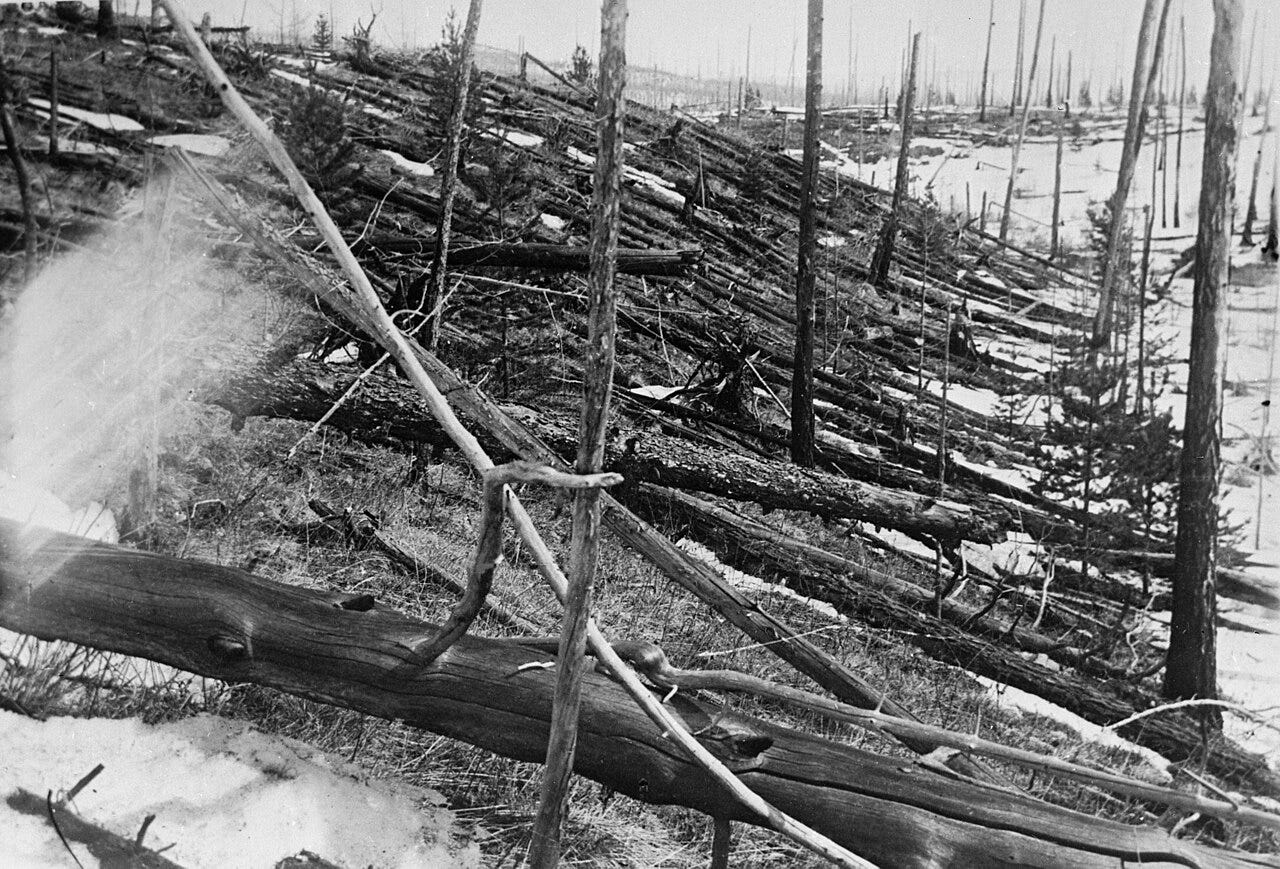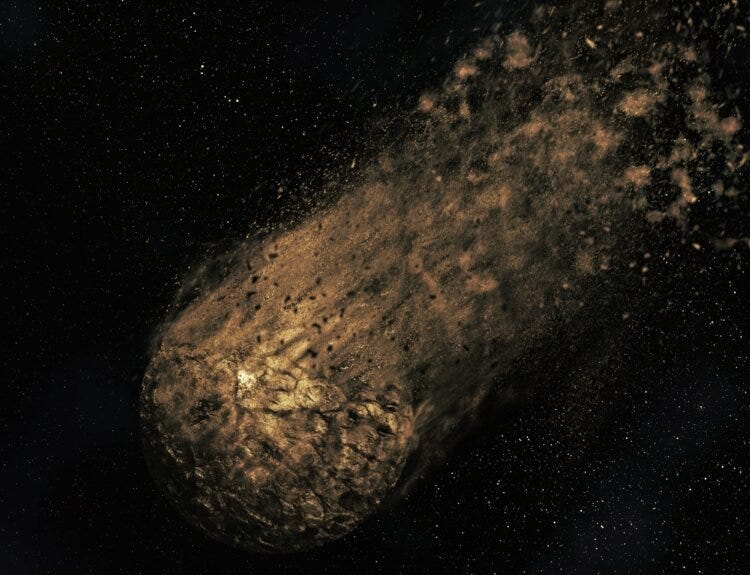Hello, Dear Reader
On the morning of June 30, 1908, at approximately 7:17 a.m., in a remote corner of Siberia, something extraordinary happened, and the world was reminded of its fragility.
A blinding flash tore through the sky above the Tunguska River, followed by a shockwave so immense it flattened 2,150 square kilometers of forest—an area larger than London! Trees were incinerated, snapped like matchsticks, or hurled to the ground in a radial pattern, as if bowing to an invisible force.
The explosion, estimated to be 1,000 times more powerful than the Hiroshima bomb, was felt hundreds of miles away. Windows shattered in distant villages, and a strange glow lit the night sky across Europe for days. Yet, no crater was found. No fragments of a meteorite. No clear answers.
This was the Tunguska Event—a cosmic enigma that continues to captivate scientists and historians to this day.
What happened that day in the Siberian wilderness?
A Fireball Over Siberia
Imagine a quiet morning in the vast taiga of central Siberia, where the Evenki people lived in harmony with the land.
At 7:17 a.m., the sky erupted.
Witnesses, mostly local tribespeople and Russian settlers, described a "second sun" blazing across the heavens. Some spoke of a fiery pillar, others of a deafening roar like artillery fire. One man, 60 kilometers away, was thn from his porch by the blast. In the trading post of Vanavara, the closest human settlement, people felt a searing heat, as if the air itself had caught fire.
The explosion released energy equivalent to 10–15 megatons of TNT, leveling 80 million trees in an instant.
Seismographs as far away as England recorded tremors.
Barometers in Germany flickered.
For days, the night skies over Europe and Asia glowed with an eerie light, bright enough to read newspapers outdoors at midnight. This phenomenon, later attributed to atmospheric dust or ice particles from the event, was a haunting reminder of the blast’s global reach.
Yet, when scientists finally ventured to the site—delayed by World War I, the Russian Revolution, and the region’s inaccessibility—they found no smoking crater, no meteorite fragments, only a scarred landscape and a lingering question:
What caused this?
The Search for Answers
The first expedition, led by Russian mineralogist Leonid Kulik, was initiated in 1921, but he only reached the site in 1927. Kulik was stunned by the devastation. Trees lay in a butterfly-shaped pattern, their trunks pointing away from the epicenter.
At the heart of the blast zone, some trees stood upright, stripped of branches, like eerie sentinels. But there was no crater, no iron or stone from the heavens—only microscopic traces of silicate and magnetite later found in the soil.
Kulik’s expeditions in the late 1920s and 1930s proposed that a meteor or comet had exploded in the atmosphere, an airburst powerful enough to devastate the forest without leaving a traditional impact site. This hypothesis remains the leading explanation today.
The object, likely 50–100 meters in diameter, is thought to have been a stony meteoroid or cometary fragment. Traveling at tens of thousands of kilometers per hour, it disintegrated 5–10 kilometers above the Earth’s surface, releasing its energy in a cataclysmic burst.
But science alone doesn’t satisfy every question.
Why did this object explode so perfectly, leaving so little trace?
Could it have been something else—a black hole fragment, an antimatter collision, or even, as some have wildly speculated, an alien craft?
These ideas, though dismissed by mainstream science, reflect our human impulse to fill the void of the unknown with stories.
Cultural Canvas is a reader-supported publication. Every like, comment, share, and donation helps us grow—your support truly matters!
A Cultural Echo
In 1908, the world was on the cusp of modernity.
The Wright brothers had just flown their first airplane, Einstein was reshaping physics, and industrialization was transforming societies.
Yet, Tunguska was a humbling reminder that forces beyond our control could alter our world in an instant.
The event inspired art, literature, and folklore. In Soviet Russia, it became a symbol of nature’s untamed power, woven into stories of cosmic wonder. Science fiction writers like Arthur C. Clarke and Stanislaw Lem drew on Tunguska’s mystery, imagining extraterrestrial causes or apocalyptic futures. Even today, it appears in video games, films, and conspiracy theories.
The Evenki people, whose lands bore the brunt of the blast, incorporated it into their oral traditions. Some spoke of a fire god or a celestial battle, weaving the event into their spiritual worldview.
The Science of the Unknown
Modern research continues to probe Tunguska’s secrets. Scientists have studied tree rings, finding unusual growth patterns in 1908, likely due to the blast’s environmental impact. Soil samples reveal tiny spherules—melted droplets of cosmic material—supporting the airburst theory.
Computer models suggest a stony asteroid, perhaps 50 meters wide, could produce the observed effects, detonating with such force that its fragments vaporized or scattered beyond detection.
Yet, alternative theories persist: some propose a volcanic gas eruption or a rare geophysical event. Others, venturing into the speculative, suggest a mini black hole or a chunk of antimatter. These ideas, while unlikely, highlight the event’s enduring mystery. Even with advanced technology, we can’t fully reconstruct what happened that day.
Why does the Tunguska Event still matter?
It’s not just the scale of the destruction or the unanswered questions. It’s what it tells us about ourselves. In an age of AI, space exploration, and global connectivity, we like to think we’ve mastered the universe’s secrets. It reminds us that Earth is a small stage in a vast cosmic drama, where a single moment can reshape landscapes and lives.
Consider this: if the Tunguska object had struck a city—say, Moscow or London—the death toll could have been in the millions.
The event’s remote location was a stroke of cosmic luck. Today, scientists monitor near-Earth objects (NEOs) to prevent such a catastrophe. Programs like NASA’s Planetary Defense Coordination Office and missions like DART (Double Asteroid Redirection Test) explore ways to deflect them.
Tunguska was a wake-up call, a reminder to look up and prepare.
But beyond the science, Tunguska it’s a story of a fleeting moment when the universe reached down and touched the Earth, leaving a scar and a question mark.
In the Tunguska region today, the forest has reclaimed the land. Young pines grow where giants fell. The Evenki still herd reindeer, and the river flows as it always has. But the memory of that fiery morning lingers, etched in the Earth and in our stories.
The Tunguska Event is a testament to the power of the cosmos and the persistence of human curiosity.
Think about it when you look at the night sky—asteroids, comets, fragments of distant worlds—hurtling through the void. One of them, over a century ago, brushed against our planet and left a mark that still makes us wonder...
Missed our last story? Read it here↓
Don’t miss the newest episode of our podcast!









Tesla
Thank you for sharing this write up! Lara Croft Tomb Raider Cradle of life with Ms.Jolie has a reference to the site!